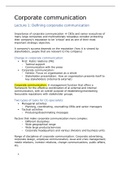Corporate communication
Lecture 1: Defining corporatie communication
Importance of corporate communication CEOs and senior executives of
many large companies and multinationals nowadays consider protecting
their company’s reputation to be ‘critical’ and as one of their most
important strategic objective.
A company’s success depends on the reputation (how it is viewed by
stakeholders, people that are relevant to the company)
Change in corporate communication:
First: Public relations (PR):
- Tactical support
- Communication with the press
Corporate communication:
- Holistic: Focus on organisation as a whole
- Stakeholder presentation: How an organisation presents itself to
key stakeholders (internal & external)
Corporate communication: A management function that offers a
framework for the effective coordination of al external and internal
communication, with an overall purpose of establishing/maintaining
favourable reputations with stakeholder groups.
Two types of tasks for CC-specialists:
Managerial activities
- Planning, coordinating, counselling CEOs and senior managers
Tactical activities
- Producing/disseminating messages
Factors that make corporate communication more complex:
- Different disciplines
- Wide geographical range
- Wide large products/services
- Corporate headquarters and various divisions and business units.
Range of disciplines of corporate communication: Corporate advertising,
corporate design, employee communication, issue and crisis management,
media relations, investor relations, change communications, public affairs,
etc.
,Key concepts:
Missions, visions, objectives, strategies
- Missions: The overriding purpose in line with stakeholders’ values
and expectations.
- Visions: The desired future state of organisation
- Objectives: Overall aims in line with overall purpose
- Strategy: How the vision is realised.
Corporate identity, corporate image, corporate reputation
- Corporate identity: Profile and value communicated by an
organization
- Corporate image: Set of association in response to
signal/message from or about a particular organisation at a
single point in time
- Corporate reputation: Collective representation of past images of
organisation over time.
Stakeholder, market
- Stakeholder: Group/individual who can affect/are affected by the
achievement of the organisation’s objectives
- Market: Defined group for whom a product/service is or may be
in demand (target group)
Communication, integration
- Communication: Tactics and media that are used to communicate
with external and internal groups
- Integrations: coordinating all communication so that the
corporate identity is effectively and consistently community to
internal and external groups
Trends in corporate communication:
1980s: Consolidated departments
- More integrations between disciplines and more strategic
communication
1990s/2000s: Positioning (corporate branding, corporate identity,
reputation)
- Gave the impression stakeholders could be controlled
2010s:
, - Stakeholders became more active (voicing, self-organising,
advocating)
- Empowered by new media (Interactive, dialogue-based)
- Stakeholders sharing their experiences, opinions, ideas about
organisations
- Electronic word-of-mouth (EWOM) and peer-to-peer influence
- Media wisdom: Credibility became more important, stakeholders
were less likely to be influenced.
- Stakeholder engagement: advocacy, transparency, authenticity,
interactivity
Communication went from a tactical tool to a strategic tool
Chapter 2: corporate communication in contemporary
organisations
Historical developments:
Industrial revolution (18th century-1930s)
- Mass production/consumption
- Increased competition rise of marketing communications.
- Publicity, promoting and selling was not controlled, the press
exaggerated
Muckraking journalism (early 20th century)
- Rise of public relations
- Raised awareness of ethical
Economic depression (1920-1930)
- Development of expertise on PR and marketing
- Were seen as separate external disciplines
Integration of 2 separate disciplines (1980s)
Marketing communication: Effectively bringing products to the
market (markets and products)
Public relations: Rise of branded content, appealed to people’s
interest (Publics and issues)
, 5 models that characterise relation PR and Marketing communication
(Kotler & Mindek):
Drivers for integration:
Organizational drivers (efficiency, accountability, positioning:
strategic direction and purpose, overlap between disciplines)
Communication-based drivers (enormous communication clutter,
message effectiveness: through consistency and reinforcement,
complementary and multiplication of media: cost inflation)





